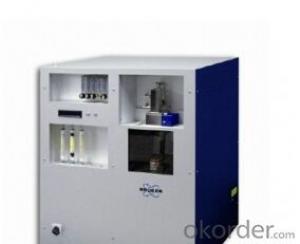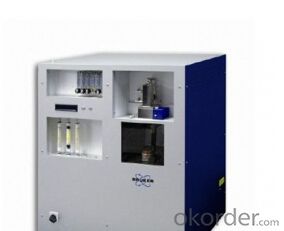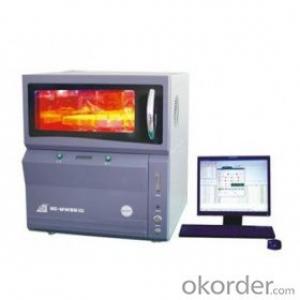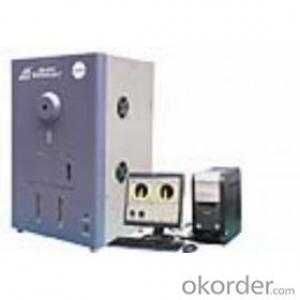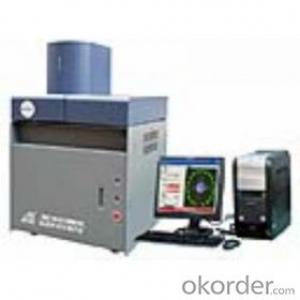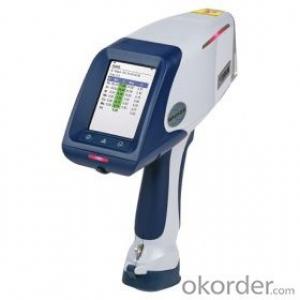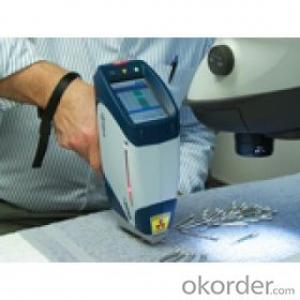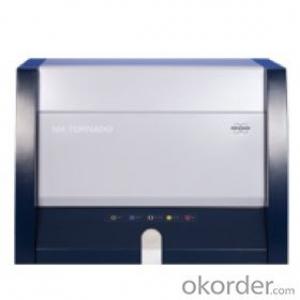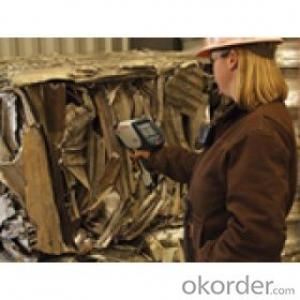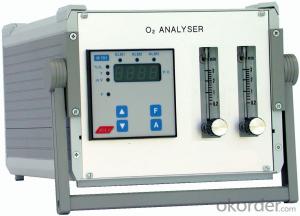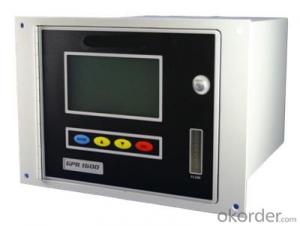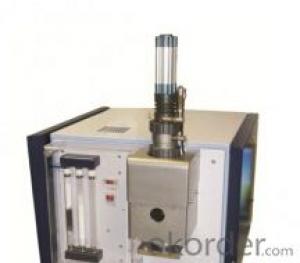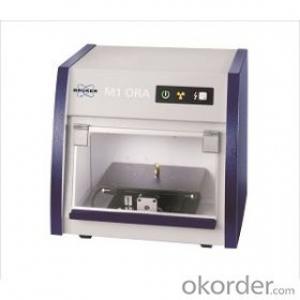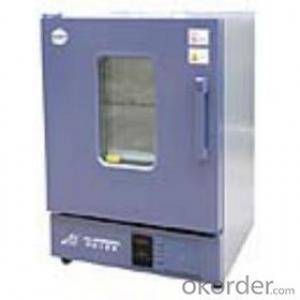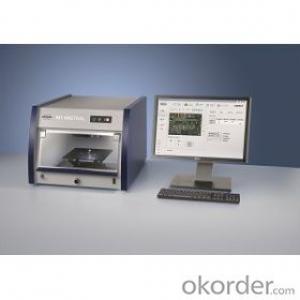Nitrogen Oxygen Hydrogen Analyzer
- Loading Port:
- China Main Port
- Payment Terms:
- TT OR LC
- Min Order Qty:
- -
- Supply Capability:
- -
OKorder Service Pledge
OKorder Financial Service
You Might Also Like
G8 Galileo hydrogen oxygen and nitrogen by German Bruker Elemental Analyzer R & D and production of a high-oxygen-nitrogen and hydrogen analyzers, the instrument uses the latest technology and production processes, manufactured by the German Kalkar plant, its main principle is: analysis of samples in an inert stream in the presence of the graphite crucible is heated and melted, wherein the pulse furnace temperature can be set freely, and through a non-contact optical sensor for real-time monitoring of temperature, for achieving complete decomposition of the sample, a mixed gas generated by the reaction by the carrier gas into the infrared and thermal conductivity detector system having a high stability and sensitivity of detection.
Fast and accurate analysis, automation;
High sensitivity infrared and thermal conductivity detector;
The total hydrogen and detection can be achieved in the diffusion of hydrogen on the same instrument;
May be associated with mass spectrometry analysis can be achieved with ultra-low content;
Using non-contact infrared thermometer temperature, with temperature-programmed function, the maximum temperature up to 3000 ° C above
Automatically selects the optimal range;
Optional automatic cleaning stove and autosampler system;
Complete safety interlock system to avoid misuse
Powerful external water cooling system, to adapt continuously to detect a large number of samples;
Windows-based operating system system, user-friendly, easy to operate
How it works:
Samples were analyzed in the presence of an inert gas stream in a graphite crucible is heated and melted, wherein the pulse furnace temperature can be freely set, and by an optical non-contact temperature sensor for real-time monitoring, to achieve complete decomposition of the sample, formed by the reaction of a mixed the gas is a carrier gas to the high sensitivity of the infrared detector and thermal conductivity detector for detection.
Instrument calibration using standard reference materials can also be carried out via the optional standard calibration gas unit, in addition, the instrument can and external infrared furnace and high-end mass spectrometer to achieve ultra-low diffusible hydrogen and hydrogen content testing.
Non-contact infrared temperature sensor
G8 Galileo is the only detection system equipped with an infrared thermometer of hydrogen oxygen and nitrogen analyzer, the reaction temperature can be achieved for real-time monitoring during analysis, thereby ensuring analysis at a set temperature.
Application of infrared temperature sensors, in some applications have unique advantages, such as morphological analysis and dynamics of some analytes, and aluminum hydrogen content detection, infrared temperature monitoring system can automatically detect the melting point, so so that the hydrogen content detection breeze.
Pulse furnace
G8 Galileo pulse furnace power can be controlled using a variety of models to respond flexibly to the needs of a variety of complex sample testing. Large rotary injection channel, you can ensure that chip samples, sample plots and debris safety injection,, and effectively remove blank.
G8 Galileo can be equipped with automatic cleaning device and a dust removal system, and automatic sampling system, which greatly improves the efficiency of sample analysis and reduce maintenance time.
Detection system
G8 Galileo high sensitivity infrared and thermal conductivity detector. Electronic frequency control effectively avoid the drawbacks of mechanical cutting light motor multiple detector system can meet the needs of a variety of high and low levels of detection.
Expand the application
G8 Galileo total hydrogen and diffusible hydrogen analyzer, equipped with diffusible hydrogen analysis components to achieve the detection of total hydrogen and hydrogen diffusion in the same instrument for the study of the formation mechanism of hydrogen embrittlement and prevention is important.
G8 Galileo mass spectrometer to achieve ultra-low hydrogen content detected in the car with super-strength steel and aerospace field has important applications.
G8 Galileo nuclear industry-specific instrument, special radiation protection design, used in the United States and France, the nuclear industry projects.
Measurement range (1g)
H: 0.01ppm-0.3%
O: 0.05ppm-6%
N: 0.05ppm-3%
Analysis time:
About 50s
Sensitivity: 0.001ppm
Power supply:
Analyzer: 400V, 7KVA
Peripherals: 230V, 800VA
Reproducibility: O, N due to 0.3%, H better than 1%
Carrier gas:
N2 purity of 99.999%
He purity of 99.996%
Pressure 2bar
Compressed air: dry, 5bar
Cooling water: about 4l / min
Instrument Size: 700 x 830x 600 mm (W x D x H)
- Q: The difference between UV Vis spectrophotometry and fluorescence spectrophotometry
- The principle of ultraviolet visible spectrophotometry is to calculate the concentration (content) of the light absorbed by the object at a particular wavelength;The method of measuring certain substances in the environment by means of fluorescence photometry is called fluorescence photometryThe concept of fluorescence spectrophotometer is big
- Q: What does the resolution parameter of the electrolyte analyzer mean?
- An electrolyte analyzer is an instrument for detecting potassium, sodium, chloride, calcium, and lithium ions from a sample.
- Q: Carbon sulfur analyzer which brand is better? Laboratory use
- The better, nature is imported brands, now carbon sulfur analysis instrument top brand of German ELTRA (in), LECO (the United States, Japan force) HORIBA (juechang).
- Q: What are the instruments for pile foundation testing?
- Ultrasonic testing instrument (detecting the compactness of pile foundation concrete), small strain gauge (percussion vibration method, detecting the overall bearing capacity of pile foundation), large strain gauge (detecting the bearing capacity and settlement of pile foundation)
- Q: What are the instrument calibration institutions? Where is the authority and the scale is relatively large?
- The third party fair laboratory specializing in instrument calibration, instrument calibration, instrument measurement and related information training.
- Q: The coal analyzer there is better
- Hebei friends and friends of Shijiazhuang glass in the Baidu search Yongfang, coal analysis instrument with good quality, good customer service service products, instrument has high detection accuracy, complete sets of equipment on coal quality testing laboratory for you all in one service. Quality free of charge, three packs a year, life-long maintenance! The quality of coal laboratory equipment, glass instrument Yongfang all know.
- Q: Just talk about the main ones, such as water analysers and so on. The main thing is to say the name of the instrument
- Water sampler, water quality parameter analysis instrument, pH meter, conductivity meter, dissolved oxygen meter, ammonia nitrogen analyzer, BOD, COD, total hardness tester, or infrared oil measuring instrument, pesticide residue detector, etc.
- Q: Only the "6840 clinical test and analysis instrument" can operate an in vitro diagnostic reagent?
- No, it is wrong to mark "6840 clinical test and analysis instrument". It must be marked with or excluding.
- Q: How to scientifically use and maintain laboratory analytical instruments
- 1, equipment management, improve the maintenance system. According to the different characteristics of the best instrument maintenance personnel and the maintenance cycle, regular maintenance, and make the relevant records, to facilitate the day after inspection.2, the use of personnel to master the instrument structure, principles, procedures and matters needing attention, to avoid misoperation caused damage to the instrument
- Q: X ray fluorescence spectrum analyzer and other analytical instruments, such as: AAS, ICP and so on, what are the advantages and disadvantages?
- The individual test experience, reference: X ray fluorescence spectrum analyzer (XRF) and ICP AAS, the former is similar to the test principle, using physical methods, with the surface electron atom binding energy reaction surface chemical composition; they are using chemical methods, qualitative and quantitative analysis were carried out using spectral wavelength and intensity of different elements; XRF test low cost, simple operation, no damage to the sample, comparing the test for homogeneous material or surface coating products, data stability and accuracy than ICP and AAS.
Send your message to us
Nitrogen Oxygen Hydrogen Analyzer
- Loading Port:
- China Main Port
- Payment Terms:
- TT OR LC
- Min Order Qty:
- -
- Supply Capability:
- -
OKorder Service Pledge
OKorder Financial Service
Similar products
Hot products
Hot Searches
Related keywords
